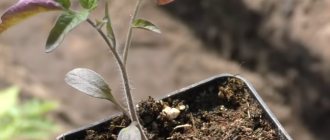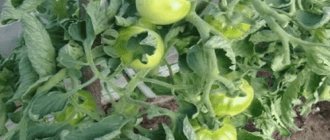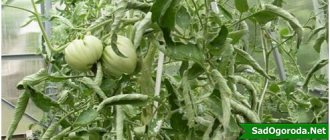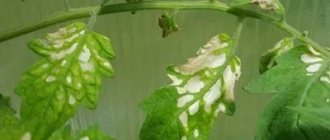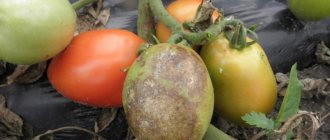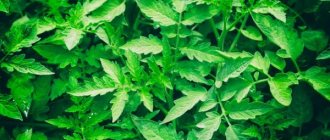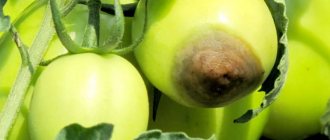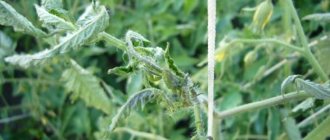- Vegetables
04.06.2019 53384
VK
Spots on tomato leaves are a good indicator of plant health. If you regularly monitor the condition of tomato leaves, you can diagnose the cause of the disease or a nutritional disorder of the bush. Early identification of a problem will help you quickly find out the causes and promptly take measures to eliminate them.
There can be several reasons for the appearance of spots on plants. As a rule, their appearance signals the onset of a disease to which tomatoes are very susceptible. Typically, various spots on tomato leaves begin to appear in the second half of summer, closer to the end of fruiting and harvest. This is quite understandable, since during this period the summer heat still lingers during the day, but the night temperature has already dropped significantly. In addition, there are fogs and cold dew in the mornings, which contributes to the occurrence of fungal diseases. Also, spots may indicate a deficiency or excess of a certain nutrient or gross errors in agricultural technology when growing tomato bushes.
So, let's look at the most common reasons for the appearance of spots on tomato leaves.
Spots on tomato leaves in a greenhouse
- 1 Spots on tomato leaves in a greenhouse
- 2 Spots on tomatoes - diagnosis
- 3 Light spots on tomato leaves
- 4 White coating on tomato leaves - powdery mildew
- 5 White spots with dark edges on tomatoes - septoria
- 6 Silvery spots on tomato leaves
- 7 Green and yellow spots on tomatoes - tomato mosaic
- 8 Yellow spots on tomato leaves - cladosporiosis
- 9 Brown spots on tomato leaves - cladosporiosis
- 10 Black spots on tomato leaves - late blight
- 11 Brown (brown) spots of tomatoes - late blight
- 12 Dark (brown) spots on tomatoes - black bacterial spot
- 13 Dark sunken spots on tomatoes - Alternaria blight
- 14 Small spots with a dark brown color - Fomoz
- 15 Tomato nutritional deficiency 15.1 Light yellow-green spots on tomato leaves - nitrogen deficiency
- 15.2 Yellow-brown spots - potassium deficiency
- 15.3 Yellow with necrotic spots - Excess potassium
- 15.4 Leaves bend upward and turn yellow - magnesium deficiency
- 15.5 Pale green spots on young leaves - sulfur deficiency
- 15.6 Purple spots - phosphorus deficiency
High humidity in the greenhouse and sudden temperature changes contribute to the appearance of diseases in tomatoes. As a rule, the development of the disease begins with the lower leaves, and if it is a fungus, then its spores very quickly spread to other parts of the plant and neighboring bushes.
In conditions of high humidity, there is a high risk of infection with brown spot, late blight, septoria, bacterial mottling , etc.
Spot control
What to do if spots appear? The fight against white spots on tomatoes is a mandatory measure, the exclusion of which will lead to loss of harvest. In any case, it is necessary to remove the crop from the garden bed, burn it and disinfect the soil, both in the fall and in the spring. There is no need to think that the disease will go away on its own and affect only one bush; this does not happen; if one plant begins to die, then others will begin to wither.
In most cases, treatment is required for crops suffering from fungal and other diseases. Folk remedies and drugs can be used in the fight. The latter are considered much more effective, especially in advanced situations.
Measures to combat diseases that cause white spots
| Name of the provoking factor | Troubleshooting process |
| White spot, septoria | As soon as spots on the leaves are discovered, it is recommended to completely remove the leaf cover and its subsequent destruction, that is, burning, but in a remote place from the garden bed. Then the cut sites are disinfected to prevent infection from getting there. Copper sulfate or charcoal is suitable for this, which is preferable to use for an adult bush with an ovary, as it is safe. After which the tomatoes are sprayed with Bordeaux mixture or copper sulfate. |
| Powdery mildew | First, damaged areas are removed and burned. The remaining shoots are treated with the drug "Zineba". |
| Brown spot | It can only be eliminated by using special drugs. The diseased areas are first removed, then treated with Bordeaux mixture. Disinfection is done every 10 days, repetition rate is 4 times. When growing seedlings in greenhouses, regular ventilation is recommended. |
| Mosaic | Treatment is based on removing diseased areas of the plant and burning them. After this, the culture is watered with skim milk, to which 2-3 tsp is added per 1 liter. urea. |
Spots on tomatoes - diagnosis
For your convenience, we have compiled a table for diagnosing problems with tomatoes by leaf color. You can immediately go to this table with photos of the most common spots on tomato leaves to make it more convenient for you to determine the cause of the problem and determine countermeasures. For a more detailed description of possible tomato diseases or other problems associated with disruption of the supply of nutrients to the tomato bush, read on.
Causes of spots
Spots should not form on healthy tomato seedlings. Whatever their nature, this is a signal of trouble. Before deciding what to do and stuffing tender seedlings with chemicals or treating them with folk remedies, you should understand the reasons.
If the substrate was disinfected and the seeds were treated before planting, spots usually appear due to improper agricultural practices or inappropriate conditions. This is the most common source of the problem.
Some gardeners do not consider these causes to be a disease. It is not right. Disease is a condition of the body, including plants, manifested in disruption of vital functions. And entailing negative consequences.
The second most common source of spots is infection. Even if tomato seedlings are infected, most diseases will appear only after moving them into the ground or greenhouse. But for some, the first signs can be seen on seedlings.
Sometimes spots on seedlings appear due to pests. This usually happens in untreated areas or in close proximity to indoor flowers.
A completely advanced case is when pests emerge from a heated substrate, if one of its components is not disinfected greenhouse or garden soil. Pest larvae and sexually mature fertilized individuals overwinter there. As the temperature rises, they emerge from hibernation earlier and begin to feed. Some leave spots on the seedlings.
Light spots on tomato leaves
If the plant has just been planted in a greenhouse or open ground in the heat, then this is a sunburn. Seedlings must be hardened off before planting. It is better to plant in the evening or in cloudy weather. You can try to help the leaves. To do this, after sunset you need to treat the leaves with anti-stress drugs: Epin, Zircon , etc. Repeat the procedure three times at intervals of a week. Usually the spots go away soon. But if the spots do not go away, you need to look for other reasons.
How to save the harvest
The first and most important thing to do when white spots are detected is to determine the cause of their occurrence and assess the extent of the damage. Depending on this, treatment methods will vary.
If it is sunburn, then the plants must be protected from the sun. There are also special “first aid” products: succinic acid, “Epin” and “Zircon”. These substances will help cope with stress, but it will not be possible to return burnt tissue.
In case of a fungal disease, you should use copper-containing preparations. They will stop the process of reproduction and development of infection. Such preparations include the fungicides “Zineb” and “Hom”, Bordeaux mixture, copper sulfate and 3% copper oxychloride. In this case, contaminated plates must be removed with a previously disinfected instrument. Sprinkle fresh sections with ash or treat with a solution of potassium permanganate.
There are no effective drugs to combat mosaic, so it is very important to choose only healthy seeds for planting and carry out annual soil replacement in the greenhouse and thermal disinfection.
White coating on tomato leaves - powdery mildew
White coating on tomato leaves, similar to spilled flour. This is powdery mildew. When powdery mildew occurs, white spots appear on both sides of the leaf. Subsequently, all the leaves fall off the affected plant, which leads to loss of yield. Low light and high humidity lead to the development of the disease. To prevent the disease, plantings should not be allowed to become dense and pruning should be carried out in a timely manner.
Powdery mildew is a very aggressive fungal disease that affects not only tomatoes, but also many other vegetables growing nearby. It spreads rapidly and can destroy all tomato plantings within a day. Diseased tomatoes must be treated with a contact-systemic fungicide. In case of severe damage, it is better to remove the diseased plants, otherwise you may lose all the plants.
It is better to remove diseased plants to avoid the spread of the disease. Treat with fungicide: Quadris, Oksikhom, Ordan, Strobi. Biological products: Fitosporin M, Baktofit, Alirin B, Gamair.
Septoria
This disease is also called white spotting. It often appears in plants grown in greenhouses. Most often, septoria develops due to waterlogging of the air or soil.
Treatment should begin immediately after the first signs appear. It’s even better to take preventive measures in advance.
Causes
White spotting develops most often for the following reasons:
- poor harvesting of plant residues - the septoria fungus settles on the remains of nightshades and spreads over time to other young crops;
- high air humidity (above 80%) and high temperatures (more than 20 degrees);
- infection through garden tools used to process infected crops;
- transmission of the fungus by humans;
- watering seedlings with contaminated water;
- spread of spores by insects and wind.
Signs
The main symptom of the disease is small light pigmentation, which grows over time. Also, then a brown border forms around the spots, the middle of the spot becomes dark. It is these signs that distinguish this disease from powdery mildew.
If left untreated, the spots enlarge, the leaves dry out and fall off.
How does it develop and why is it dangerous?
The disease develops rapidly. Also, fungi are easily transmitted, so other plants quickly become infected.
Crops die quickly - 2-3 weeks of disease spread are enough, and the leaf blades will disappear. Because of this, photosynthesis will not occur, which will lead to the death of the seedlings.
How to treat?
Traditional methods
Tomatoes can be cured using folk remedies. However, this is only possible if the fungus is noticed immediately.
The following remedies work best against white spotting:
- Salt solution. Dissolve a glass of salt in 10 liters of water. The culture is treated with the prepared mixture. Frequency of treatment – 2-3 times a week.
- Garlic tincture. Pass ten heads of garlic through a press and add a liter of water. Dilute the resulting solution with a bucket of water and leave for 2-3 hours. Before use, strain the solution so that no garlic residue remains in it. Treatment is carried out every other day.
- Iodine solution. Take a liter of milk and 20 drops of iodine per bucket of water. Mix all components thoroughly. Process tomatoes in the evening for a month once a week.
Chemicals
The following drugs will help cope with spotting:
- "Thanos." Dissolve 6 mg of the product in 10 liters of water and treat the tomatoes. Pay special attention to the lower leaves. Spray tomatoes twice with a break of two weeks. Cost 400 g 1200-1400 rub.
- "Revus top." In the first stages of damage, 6 mg of the drug per 10 liters of water is sufficient. At an advanced stage of the disease, you will need twice as much product. Spray the crop no more than 3 times, maintaining an interval of at least two weeks. Packaging price – 60-70 rubles.
When processing tomatoes, wear protective clothing and ventilate the room.
Biological drugs
The following remedies also kill septaria, but they are absolutely harmless to humans:
- Planriz. The solution is prepared according to the instructions. Treatment is carried out every 2 weeks. The drug is also suitable for preventive treatment of seeds.
- Fitosporin M. The drug helps not only to destroy pathogenic microorganisms, but also to increase immunity. The prepared solution can be used to treat soil, seeds and seedlings.
other methods
The following methods of combating white spotting cannot be independent; they must be combined with treatment with chemical or biological agents.
Such control methods include removing affected leaf blades from the bush, as well as normalizing soil and air humidity.
Prevention
Preventive measures will help prevent white spot infestation.
Such events include:
- Soil cultivation. Before sowing seeds for seedlings, the soil must be calcined in a microwave or oven. In the first case, process for 2-3 minutes, and in the oven for 15-20 minutes at a temperature of 180-200 degrees.
- Seed treatment. They need to be soaked in a weak solution of potassium permanganate for a day. After that, let them dry.
White spots with dark edges on tomatoes - septoria
If cloudy white spots with dark edges start from the lower leaves and then spread further, if they leave the impression of a gray coating, then most likely this is septoria - a very dangerous fungal disease. If you do not take any action, black dots will appear in the middle of the white spots, the leaves will darken and fall off. The disease can affect other leaves, stems, and fruits. The plant could become infected if the soil was poorly prepared; fungal spores could remain in it. The seed material could be contaminated, which is why the seeds need to be treated before sowing. Septoria usually develops in July because it is triggered by high humidity and intense heat.
Spots on tomato leaves and what to do? See here
Infected plants must be removed and destroyed. The disease is difficult to treat. At the initial stages of the disease, plants are treated with fungicides: Bordeaux mixture, Oksikhom, Hom, Revus. Effective biological products: Fitosporin M, Alirin.
Stains left by pests
At the seedling stage, tomatoes should not have pests. It is the gardeners’ fault that they appear. Stains can be left by:
- Whitefly. This is a gnawing pest, but you can’t avoid it. Firstly, the whitefly lays eggs that look like white spots; the larvae leave yellow dots when feeding. And secondly, the insect is a carrier of sooty fungus, which causes the leaves to turn black.
- Spider mite. The first manifestation of the pest is yellow dots on the leaves of seedlings. The underside of the plate is covered with a gray coating and thin cobwebs. Appears when indoor flowers are close together or is carried by people and pets. Spreads in dry air and high temperatures.
- Aphid. A sucking pest, it leaves dots on the leaves, but it is impossible to see them under a layer of small insects. They themselves look like elongated black or red spots.
- Nightshade miner. Quarantine pest of open and protected ground. The greatest danger is posed by larvae that gnaw passages inside the leaves and leave transparent spots. It is found in the soil and on seed material, from where it gets onto tomato seedlings.
Pests need to be controlled with insecticides, preferably systemic ones. It is difficult to destroy spider mites; the preparations must have an acaricidal effect.
Silvery spots on tomato leaves
Some gardeners are frightened by the appearance of such silvery spots on the leaves, mainly in greenhouses. This is not a disease, but a physiological disturbance in the development of the plant (anomaly). This occurs due to sharp changes in night and day temperatures, as well as due to genetic changes when seeds of poorly processed hybrids go on sale. These physiological manifestations are not dangerous, so there is no need to worry if you experience these symptoms. You can use anti-stress drugs: Epin, Zircon , etc., timely ventilation and closing of the greenhouse.
Preventive measures
An illness or sunburn that has already manifested itself is difficult, and sometimes impossible, to cure. To prevent stains from appearing on tomatoes, you must adhere to the following rules:
- Disinfection of seeds and soil before planting.
- Regular disinfection of garden tools.
- Proper crop rotation (the location of the beds should be changed every three years or more often).
- Timely weeding.
- Compliance with the watering regime.
- Maintaining a constant climate in the greenhouse (temperature from +20 to 28 degrees, humidity no more than 75%).
- Ventilation.
- Adding necessary fertilizers to the soil.
- No mechanical damage to the landings.
Green and yellow spots on tomatoes - tomato mosaic
In tomatoes affected by this disease, a characteristic mosaic pattern appears on the tops in the form of alternating green and yellow spots. In young leaves, the mosaic pattern is more clearly visible than in older leaves. The disease spreads very quickly to nearby tomato bushes. In the future, yellowish spots may appear on the fruits. This is tomato mosaic , a viral disease. The virus is transmitted by insect pests in the soil, but first of all, infection occurs with seeds. Therefore, to prevent mosaic, it is necessary to choose seeds of hybrids that are immune to this virus. If there is no data on the variety’s resistance to mosaic virus, then the planting material must be pickled in a 1% solution of potassium permanganate for 20 minutes.
Plants affected by mosaic are not treated , but are removed from the site and then destroyed.
Reasons for whitening of tomato leaves
Tomato seedlings are usually grown indoors: stable air temperature, absence of precipitation and wind, contribute to the fact that the seedlings grow together, become stronger, and grow green leaves. The only disadvantage of growing seedlings at home is the lack of lighting, which is usually compensated for by artificial light lamps.
In such favorable conditions, seedlings grow of high quality, but tender. She was not used to changeable weather, sharp temperature fluctuations, bright ultraviolet rays, or cold spring precipitation.
Having planted seedlings outdoors, after a few days you can see that the upper leaves have changed color - they have become completely white. If in adult plants the cause may be a disease, attack by pests or a lack of microelements in the soil, then in seedlings this happens for a completely different reason.
Tender plants transplanted into the ground experience stress. It manifests itself in a change in the color of the leaves from green to white, while the whiteness appears evenly, without spots or dots. After some time, these leaves may fall off.
Yellow spots on tomato leaves - cladosporiosis
Small yellow spots, first on the lower, then on the upper leaves of tomatoes. These are the initial signs of the fungal disease cladosporiosis (brown spot, leaf mold).
Subsequently, on the back side of the leaves, the space under the spots becomes covered with a light gray coating (later becomes brown). The leaves curl and dry out.
When an infection occurs, you need to spray the plants with the following preparations: Quadris, Abiga Peak, Polychom, Tsineb. Among the biological products that are effective: Alirin, Fitosporin M, Pseudobacterin
Cladosporiosis of tomato causes great harm in greenhouses. The shortfall in fruit yield reaches 30–40%. Brown spot can be stored in greenhouses for up to ten years, so it is important to disinfect the greenhouse and soil when the disease appears.
Treatment of seedlings
Experts believe that there is no point in treating seedlings affected by septoria. Even if it is possible to contain the development of infection, the seedlings grow weak and susceptible to disease. Such plants produce very low yields and can become a source of infection in the area.
Therefore, at the first signs of septoria, the plant and soil are destroyed. Before sowing new seedlings, the container is disinfected with a 2% solution of 40% formaldehyde.
The remaining seedlings are sprayed with the biofungicide "Fitosporin M". To prepare the solution, 2.5 g of powder is diluted in 5 liters of water. After 10 days, the treatment is repeated.
But still, some gardeners try to treat seedlings with white spotting. To do this, the plants are isolated, the soil is spilled with an aqueous solution of potassium permanganate (1.5 g/10 l) and dusted with wood ash.
The culture is sprayed with a 0.1% solution of copper sulfate. When using more concentrated solutions, burns may occur.
Brown spots on tomato leaves - cladosporiosis
Brown spots on tomato leaves appear first in the lower part of the bush, then spread to the upper leaves. After some time, a dark velvety coating forms on these spots. Less commonly, flowers and fruits are infected, which turn brown and fall off if infected.
These are clear signs of the spread of the dangerous fungal disease cladosporiosis ( brown spot, leaf mold. Spots on tomato leaves and what to do? See here
Black spots on tomato leaves - late blight
This is a clear sign that tomatoes are affected by late blight. This is the most dangerous and common fungal disease that occurs in both ground and greenhouse tomatoes. Develops from dampness against the background of a sharp temperature change. Black-brown spots appear on all parts of the plants: first the leaves turn black and dry out, and then black spots and necrosis appear on the fruits. The earlier the disease is detected, the greater the chances of saving the plant and avoiding the spread of the disease. If there are obvious signs of the disease, the plant cannot be cured. The main thing is to contain the spread of infection, otherwise you may lose the entire harvest.
Diseased leaves must be removed immediately upon detection. This must be done extremely carefully, as fungal spores can get on healthy plants. Plants need to be treated with chemical fungicides: Hom, Ordan, Oksikhom, Profit Gold, Revus, etc. Treatment should be done once every 7 days, the frequency of treatments is indicated in the instructions for the drug.
Biological products used: Alirin B, Gamair, Fitosporin M, Trichodermin
Solving problems with yellowed leaves
Before you start to fight the problem and save the seedlings, you should clearly understand the cause. Each disease has its own individual symptoms, which can be used to clearly understand the problem.
Diseases of tomatoes in a greenhouse and their treatment When planting tomatoes in greenhouses and greenhouses, we, of course, first of all, dream of an early harvest, and also try to protect...
Insufficient nutrition
Very often, changes in leaf color depend on a lack of certain microelements.
- With a lack of copper, but an excess of organic substances, the surface of the leaves becomes speckled with a pale light green or yellowish color.
- With a lack of manganese, the lower tier turns yellow, and the new one grows speckled.
- A lack of iron will cause yellowing and falling leaves.
- With a lack of nitrogen, inclusions of light green or yellow color appear.
- With a lack of magnesium, pigmentation is not only yellow, but brown or dark red.
It is very easy to correct such a problem of lack of microelements - just start regularly applying fertilizers, which contain a predominance of the missing microelements.
Burn from direct sunlight
The color of the leaves can be affected by improper lighting. Spots of white or light yellow color can appear either from an excess of direct sunlight or from a lack of it.
With a sunburn, the density of the spots can be completely different: from small specks to large spots that cover the entire surface.
In these places, the tissue dies off completely, which is quite dangerous and can lead to death if the plant is not saved. For faster recovery, you can use the Epin solution, which is sprayed on plants after removing the affected areas. The tomatoes will develop more slowly, but you will still get the desired harvest. The only consequence is that it may ripen a little later than expected.
On a note!
Most often, spots form in those places where water gets during irrigation. Its drops become a kind of lenses. Therefore, when watering seedlings, make sure that water does not fall on the vegetative part of the plant, but is only absorbed into the soil.
To avoid sunburn, you should follow simple care rules.
- It is necessary to grow tomato seedlings in the brightest place in the house, and after transferring them to the greenhouse, young bushes are protected from direct sunlight.
- Tomatoes should be watered in the evening or in the morning, when there is no scorching sun.
- Watering is carried out strictly at the root.
Such simple measures will help to avoid the death of plants from direct sunlight.
High humidity
If the room has high humidity, is not regularly ventilated, or is watered too often, then yellow spots will begin to appear on the leaves. In such conditions, fungal diseases begin to develop.
To correct the situation, it is enough to normalize the watering schedule. Tomatoes need regular, abundant but infrequent watering. It is enough to water the crop 2 times a week.
Brown spot
This is a fungal disease that first affects the lower tier of leaves and then moves up the bush. First, small yellow spots appear, which gradually grow and merge. The fruits of adult plants are not affected. If you do not take action, then gradually all the leaves will turn brown, dry out and fall off.
Action should be taken when spots appear on the lower leaves. They are removed, and the plant should be treated with a biological fungicide. The rules and number of procedures are always indicated in the instructions for the drug.
You can reduce the rate of fungal development by adjusting humidity. When humidity is less than 70%, the development of fungal pores stops. Similar actions are carried out to treat any fungal diseases.
Viral mosaic
The first sign of the disease is uneven coloring of the leaves, yellowish spots and inclusions appear on them. The leaves also curl downward. The affected plant can no longer be saved; it is destroyed so that the virus does not switch to other plants.
As an effective preventive measure, seeds should be disinfected by soaking them in a solution of potassium permanganate. The most common cause of this disease is initially infected seeds.
The main thing for a gardener, if yellow spots or spots appear on the leaves of tomatoes, is to correctly identify the cause and take the necessary measures. The sooner treatment is started, the higher the likelihood that the future harvest will be virtually unaffected.
Brown (brown) spots of tomatoes - late blight
Brown spots appear on the lower leaves of the tomato, then throughout the plant. Unripe fruits turn brown. In cold weather, a whitish-gray coating appears along the edges of the spots on the leaves. With increased humidity, damaged leaf tissue softens. These signs also signal that the tomato bush is infected with late blight. Spots on tomato leaves and what to do? See here
Dark (brown) spots on tomatoes - black bacterial spot
The spots do not merge into large and dark ones, as with late blight, but rather look like a black rash. Symptoms of black bacterial spot of tomatoes.
Initially, small spots of olive color appear on the leaves, oily in appearance, only about 1-2 mm in diameter. Quite quickly they darken and spread, covering all larger parts of the leaf and stems.
All above-ground parts of the plant are affected: leaf petioles, sepals, stalks, tomatoes and peppers. As the fruits grow, spots also appear on them, their number increases, by this time the stems and leaves seem to be covered with scabs. Due to malnutrition, the fruits do not ripen, and the leaves gradually dry out and fall off. Yield losses can be 90-100% - rotting of the fruit tissue occurs under the spots. Loss of leaf mass from 50 to 100%.
Treatment with chemicals is carried out with copper-containing fungicides - spraying with a 1% solution of Bordeaux mixture, preparations Hom, Oxychom, Ordan, etc.
Among the biological preparations, the drug Fitolavin is very effective on tomatoes - it helps to treat not only bacterial black spot, but also bacterial cancer, tomato blossom end rot and other nightshade diseases
Tips and recommendations from experienced summer residents
Take advice from experienced gardeners on how to prevent crop loss:
- Do not plant seedlings on a hot day. If weather forecasters predict hot weather, it is better to postpone planting for a couple of days.
- Hopelessly diseased plants should be uprooted and burned. After the procedure, thoroughly wash your hands and wash your clothes to prevent re-infection.
- Before planting, it is better to prepare the seedlings for sunlight. To do this, place containers with seedlings in the sun every day for 1.5-2 hours for a week.
- When watering, the water should be warm or slightly cool.
- Everything should be in moderation: sun, water, and fertilizers.
Dark sunken spots on tomatoes - Alternaria
There are rounded dark depressed spots on the leaves, stems, and fruits. This disease manifests itself in hot weather - Alternaria (macrosporiasis). The size of the spots can reach several centimeters and they will be dry in any weather. The disease causes yellowing of the plant's leaves. A distinctive sign of its appearance is spots of black plaque on the leaves and fruits.
What to do? Treatment with fungicides: Quadris, Hom, Ordan, Profit Gold, Oksikhom, Bordeaux mixture. Treatment with biofungicides: Alirin, Fitolavin, Fitosporin M, Trichodermin
Problem two: tomato seedlings turn pale, yellow, leaves dry out and fall off
Is it possible to save already affected plants? It is possible if you transplant them into fresh soil. The roots of each seedling must be freed from the previous soil, make sure that they are white and healthy (if the roots are yellow, black or rotten, the seedlings cannot be saved) and transplanted into light, slightly moist soil. Pour 20 ml under each plant. pink solution of potassium permanganate and place the cups in a sunny window. It may happen that during the transplantation process the roots are damaged and the seedlings wither in the light. Then you should shade them for the first time. But after rooting, good lighting and infrequent watering are mandatory and necessary conditions for the further development of seedlings.
If you follow the rules of watering and your seedlings have enough light, but they still turn yellow or pale, you should pay attention to the nature of the change in leaf color. Perhaps the plant is lacking one or another nutritional element that needs to be replenished
Small spots with a dark brown color - Fomoz
Numerous small dark brown to black spots appear on the leaves, which may form concentric rings as they increase in size. This is Phomaz (Phomosis rot) . In case of illness
Fruits, both unripe and ripe, are affected. Phoma can be identified by the characteristic brown spot that appears near the stalk. Then it increases in diameter, but not much. Typically the spot reaches a size of about 3 centimeters. The main spread of rot occurs inside the fruit.
The pathogenic fungus can survive in the soil, in contaminated plant debris, as well as on pepper plants and closely related weeds. The spread of the disease is facilitated by high humidity and fertilizing rich in nitrogen. Spots on tomato leaves and what to do? See here
As a preventive measure, the soil is disinfected, and it would not be a bad idea to treat the internal parts of the greenhouse with a disinfectant solution.
Treatment is carried out with the following drugs: Bordeaux mixture, Hom, Oxychom. Diseased fruits must be collected and destroyed.
Prevention of white spotting
Protective measures almost completely eliminate septoria of tomatoes. First of all, this is planting varieties or hybrids of tomatoes that are resistant to the pathogen. This is especially important in cases of infection occurring on the site in the previous year.
Seeds from questionable sources and domestic tomatoes are disinfected. To do this, they are placed in a fabric bag with a weight and dipped in one of these solutions: 1% potassium permanganate (20 minutes), 2-3% hydrogen peroxide (8-10 minutes). Then dried under the sun. You cannot use the seeds of diseased tomatoes, even after dressing.
Other protective measures:
- cleaning and destruction of plant residues;
- disinfection or complete replacement of soil;
- disinfection of greenhouses and greenhouse structures;
- control over humidity (prevent condensation) and air temperature in the greenhouse;
- maintaining optimal space between tomato bushes and other nightshade crops;
- timely pruning of bushes before the foliage closes;
- compliance with crop rotation (tomatoes cannot be planted in one place for 3 years);
- disinfection of working tools;
- watering at the root to avoid moisture getting on the leaves;
- sheltering tomatoes during long rainy periods.
Any disease attacks weakened plants more quickly. Therefore, from the moment you plant tomatoes, you need to monitor their immunity. Do not forget to timely feed with mineral and organic fertilizers, spray with biostimulants, monitor the safe threshold of pests, and soil condition.
In greenhouses, sudden changes in day and night temperatures, drafts and constant formation of condensation are dangerous.
Tomato nutritional deficiency
You can read more about nutritional deficiencies in the article on our website “What tomatoes lack: nutritional deficiencies.” You can determine which microelements the plant lacks by the appearance of tomato leaves. Their color, and the general condition of the leaf . The deterioration of the condition of tomatoes is most often caused by a deficiency (less often, an excess) of micronutrients. What kind of feeding tomatoes need can be determined by the change in color and condition of the leaves of the tomato bush. Now we will consider diagnosing a deficiency or excess of nutrients only by the presence of spots on tomato leaves.
Light yellow-green spots on tomato leaves - nitrogen deficiency
Tomatoes burn at the edges, old leaves turn yellow and fall off. Plants stretch out, look stunted, leaves become smaller, acquire a light green color with a yellowish tint, and the stem becomes soft. The veins on the underside of the leaf are reddish-bluish in color.
What to do? Feed the tomatoes with nitrogen fertilizer, for example, urea (1 tablespoon per 10 liters of water). Spots on tomato leaves and what to do? See here
Yellow-brown spots - potassium deficiency
Young tomato leaves roll up inside a tube - they become curly, and old leaves turn yellow and dry out at the edges. First, the leaves darken, then yellow-brown spots appear along the edges, which gradually grow, forming a border.
What to do? Fertilizing with potassium nitrate (1 tablespoon of fertilizer per 10 liters of water) half a liter of solution per bush, spraying the leaves with a solution of potassium chloride (1 teaspoon per 1 liter of water).
Yellow with necrotic spots - Excess potassium
With an excess of potassium, the lower leaves of tomatoes turn yellow and dark necrotic spots appear on them). Excess potassium is dangerous for plant roots. High potassium content can cause burns to the root system. In addition, excess potassium leads to difficulty in the absorption of nutrients such as calcium, magnesium, zinc, boron, etc.
What to do? Stop fertilizing with potash fertilizers and ash. Spots on tomato leaves and what to do? See here
Leaves curl upward and turn yellow - magnesium deficiency
Tomato leaves curl upward and begin to turn yellow between the veins.
What to do? Foliar feeding (spraying on the leaves) with a solution of magnesium nitrate (1 teaspoon per 10 liters of water) or Epsom salt diluted in the same proportion helps well.
Pale green spots on young leaves - sulfur deficiency
Signs of sulfur deficiency are similar to nitrogen deficiency: pale green leaf color turning yellow, red-blue veins. But sulfur deficiency appears first on young leaves (with nitrogen the opposite is true). The stem of the plant also becomes thinner, it becomes brittle, brittle, and woody.
What to do? Foliar feeding with magnesium sulfate (1 gram per 1 liter of water) helps.
Purple spots - phosphorus deficiency
The leaves and stems of tomatoes darken to a dark green color with a blue tint, the lower part of old leaves acquires a purple tint. The leaves curl inward, the stem becomes stiff and brittle, and the roots wither. The tomato leaf color and stem may turn purple. At the same time, the leaves rise up and are pressed against the stem.
What to do? Feed the tomatoes with phosphorus-containing fertilizer. To prepare the fertilizer, pour 1 liter of boiling water into 1 cup of superphosphate and leave to steep for 8-12 hours. Dilute the resulting infusion in 10 liters of water and pour half a liter of fertilizer under each bush.
Tomato diseases
The most common diseases with white spots on tomatoes:
- a disease such as septoria;
- white spotting in tomatoes;
- a large lack of many minerals, and as a result the appearance of plaque.
The last problem occurs due to the fact that tomatoes are planted in the same place every year, and at the same time, without giving the required amount of fertilizer, and then the earth takes all the minerals for itself, is completely depleted and, as a result, the plants do not receive vitamins and get sick . Tomatoes do not have a strong immune system at first.
White rot
Have you noticed that the leaves are turning white? This is a fungal disease that is actually quite rare, but does occur. The disease most often affects new, young seedlings that have not yet been able to build their immunity in a greenhouse. The nature of the disease when the leaves turn white:
- plants in their structure change from a solid state to a softer one, and mucus appears on the leaves;
- at the very beginning of the stem they appear as white sacs, they resemble as if a spider has woven a web;
- the color of the pillar itself becomes dark and not bright;
- as a result, after some time the plant loses its appearance, dries out and dies: after this, it is difficult for tomatoes to restore the root system.
A similar disease appears, most often, due to the fact that the temperature in the room very often drops down and stays there. In addition, poor ventilation in the greenhouse has an effect. Therefore, if you notice such symptoms in your plants, you need to start treating them immediately.
- All particles that are already infected with the disease must be immediately cut off and destroyed so that the disease does not spread to other bushes.
- All places where you cut the branches must be treated so that there is no new infection.
- Then absolutely all plants must be sprayed with a special mixture, it can be copper sulfate or Bordeaux-type liquid.
Pay close attention to the temperature; it should not drop much and remain at the same level; also carefully monitor the humidity. If the temperature is low and humidity is high, this can lead to the progression of the disease.
Brown spot
The disease develops from high humidity
Most often, such a disease begins to manifest itself at those moments when all the fruits on the bushes begin to ripen and develop. An interesting fact is that such a disease affects certain areas of the bush:
- a small fluff may appear on the underside of all leaves, which will be white;
- over time, such fluff can change its color from white to darker, and its structure will more resemble rot rather than fluff;
- but the upper part of the leaf will also change its color and instead of greenish it will become light yellow with a dirty shade of brown;
- also another characteristic feature of the disease is that then all the leaves are wrapped in a tube and dry out; this is an uncommon occurrence in tomatoes.
It is this disease that progresses and develops only in greenhouses, where there is a very high percentage of humidity and an increased percentage of temperature. Advice from experienced gardeners is that it is necessary to regularly ventilate the room every day so that the temperature and humidity are always normal. As an excellent method of prevention, it is necessary to spray tomatoes every 6 days with a liquid called Bordeaux. This is an excellent way to overcome the disease and prevent it from entering the active reproduction stage.
Powdery mildew
The disease never affects young bushes, always only ripe and mature plants that already have a strong and good root system. The main causative agent of this disease is a fungus that multiplies in mature spores. Tomato roots may rot. The main “symptoms” of the disease when the leaves turn white:
- It is quite difficult to immediately notice the disease, since it develops only on the inside of the leaves; they resemble small grains of flour or semolina grains;
- yellowish spots with white dots may appear on the outside of tomato leaves;
- After some time, the leaves begin to dry out and fall off sharply.
This disease is quite difficult to overcome, since it is firmly rooted in the tomato system and does not go away. The percentage is 40 to 60 that the tomatoes will be able to survive and return the bush to tone and productivity. A similar disease appears only when the temperature in the room is constantly changing, and it is constantly jumping, then up, then down. The plant needs to be watered more, given additional fertilizers and treated with special preparations.
